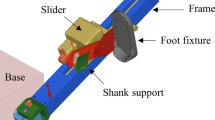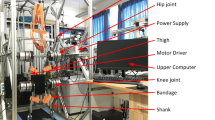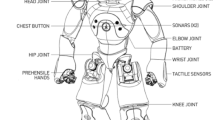Abstract
There are a certain number of arm dysfunction patients whose legs could move. Considering the neuronal coupling between arms and legs during locomotion, this paper proposes a novel human-robot cooperative method for upper extremity rehabilitation. Legs motion is considered at the passive rehabilitation training of disabled arm, and its traversed trajectory is represented by the patient trunk motion. A Kinect based vision module, two computers and a WAM robot construct the human-robot cooperative upper extremity rehabilitation system. The vision module is employed to track the position of the subject trunk in horizontal; the WAM robot is used to guide the arm of post-stroke patient to do passive training with the predefined trajectory, and meanwhile the robot follows the patient trunk movement which is tracked by Kinect in real-time. A hierarchical fuzzy control strategy is proposed to improve the position tracking performance and stability of the system, which consists of an external fuzzy dynamic interpolation strategy and an internal fuzzy PD position controller. Four experiments were conducted to test the proposed method and strategy. The experimental results show that the patient felt more natural and comfortable when the human-robot cooperative method was applied; the subject could walk as he/she wished in the visual range of Kinect. The hierarchical fuzzy control strategy performed well in the experiments. This indicates the high potential of the proposed human-robot cooperative method for upper extremity rehabilitation.












Similar content being viewed by others
References
Song A, Pan L, Xu G, Li H (2015) Adaptive motion control of arm rehabilitation robot based on impedance identification. Robotica 33(9):1795–1812. doi:10.1017/S026357471400099X
Go AS, Mozaffarian D, Roger VL et al (2014) Heart disease and stroke statistics-2014 update: a report from the American Heart Association. Circulation 129:28–292. doi:10.1161/01.cir.0000441139.02102.80
Maciejasz P, Eschweiler J, Gerlach-Hahn K, Jansen-Troy A, Leonhardt S (2014) A survey on robotic devices for upper limb rehabilitation. J Neuroeng Rehabil 11:3. doi:10.1186/1743-0003-11-3
Krebs HI, Palazzolo JJ, Dipietro L et al (2003) Rehabilitation robotics: performance based progressive robot-assisted therapy. Auton Robots 15:7–20. doi:10.1023/A:1024494031121
Rosati G, Gallina P, Masiero S (2007) Design, implementation and clinical tests of a wire-based robot for neurorehabilitation. IEEE Trans Neural Syst Rehabil Eng 15(4):560–569. doi:10.1109/TNSRE.2007.908560
Spencer SJ, Klein J, Minakata K, Le V, Bobrow J E, Reinkensmeyer D J (2008) A low cost parallel robot and trajectory optimization method for wrist and forearm rehabilitation using the Wii. In: Proceedings \(2^{\rm nd}\) IEEE RAS&EMBS international conference on biomedical robotics and biomechatronics, Scottsdale, pp 869–874. doi:10.1109/BIOROB.2008.4762902
Nef T, Mihelj M, Riener R (2007) ARMin: a robot for patient-cooperative arm therapy. Med Biol Eng Comput 45(9):887–900. doi:10.1007/s11517-007-0226-6
Perry JC, Rosen J, Burns’ S (2007) Upper-limb powered exoskeleton design. IEEE/ASME Trans Mechatron 12(4):408–417
Sanchez R, Reinkensmeyer D, Shah P et al (2004) Monitoring functional arm movement for home-based therapy after stroke. In: Annual international conference of the IEEE engineering in medicine and biology, pp 4787–4790: doi:10.1109/IEMBS.2004.1404325
He W, Ge SS, Li Y, Chew E, Ng YS (2015) Neural network control of a rehabilitation robot by state and output feedback. J Intell Robot Syst 80(1):15–31. doi:10.1007/s10846-014-0150-6
He W, Chen Y, Yin Z (2016) Adaptive neural network control of an uncertain robot with full-state constraints. IEEE Trans Cybern 46(3):620–629. doi:10.1109/TCYB.2015.2411285
He W, Dong Y, Sun C (2016) Adaptive neural impedance control of a robotic manipulator with input saturation. IEEE Trans Syst Man Cyber Syst 46(3):334–344. doi:10.1109/TSMC.2015.2429555
Xu G, Song A, Li H (2011) Control system design for an upper-limb rehabilitation robot. Adv Robot 25(1):229–251
Richardson R, Brown M, Bhakta B, Levesley MC (2003) Design and control of a three degree of freedom pneumatic physiotherapy robot. Robotica 21:589–604. doi:10.1017/S0263574703005320
Webster D, Celik O (2014) systematic review of kinect applications in elderly care and stroke rehabilitation. J Neuroeng Rehabil 11:108. doi:10.1186/1743-0003-11-108
Du G, Zhang P (2014) Markerless human-robot interface for dual robot manipulators using Kinect sensor. Robot Comput Integr Manuf 30:150–159
Chang YJ, Chen SF, Huang JD (2011) A Kinect-based system for physical rehabilitation: a pilot study for young adults with motor disabilities. Res Dev Disabil 32(6):2566–2570
Hussain A, Roach N, Balasubramanian S, Burdet E (2012) A modular sensor-based system for the rehabilitation and assessment of manipulation. In: Haptics symposium (HAPTICS), 2012 IEEE, pp 247–254. doi:10.1109/HAPTIC.2012.6183798
Su CJ, Chiang CY, Huang JY (2014) Kinect-enabled home-based rehabilitation system using Dynamic Time Warping and fuzzy logic. Appl Soft Comput 22:652–666
Riener R, Lunenburger L, Jezernik S et al (2005) Patient cooperative strategies for robot-aided treadmill training: first experimental results. IEEE Trans Neural Syst Rehabil Eng 13(3):380–394. doi:10.1109/TNSRE.2005.848628
Wolbrecht ET, Chan V, Reinkensmeyer DJ, Bobrow JE (2008) Optimizing compliant, model-based robotic assistance to promote neurorehabilitation. IEEE Trans Neural Syst Rehabil Eng 16(3):286–297. doi:10.1109/TNSRE.918389
Dietz V, Fouad K, Bastiaanse CM (2001) Neuronal coordination of arm and leg movements during human locomotion. Eur J Neurosci 14(11):1906–1914. doi:10.1046/j.0953-816x.2001.01813.x
Ferris DP, Huang HJ, Kao PC (2006) Moving the arms to activate the legs. Exerc Sport Sci Rev 34(3):113–120
Yoon J, Novandy B, Yoon CH, Park KJ (2010) A 6-DOF gait rehabilitation robot with upper and lower limb connections that allows walking velocity updates on various terrains. IEEE/ASME Trans Mechatron 15(2):201–215. doi:10.1109/TMECH.2010.2040834
Ni C, Fu J, Han R et al (2000) Rehabilitation therapy on recovery of the paretic arm functions in stroke patients. Chin J Phys Med Rehabil 22:204–206
Cong G, Pu S (2001) Effects of early rehabilitation on motor function of upper and lower extremities and activities of daily living in patients with hemiplegia after stroke. Chin J Rehabil Med 16(1):27–29
Pan L, Song A, Xu G, Xu B, Xiong P (2013) Hierarchical safety supervisory control strategy for robot-assisted rehabilitation exercise. Robotica 31:757–766. doi:10.1017/S0263574713000052
Song A, Wu J, Qin G, Huang W (2007) A novel self-decoupled four degree-of-freedom wrist force/torque sensor. Measurement 40(9):883–891. doi:10.1016/j.measurement.2006.11.018
Yu T (2014) Kinect application and development: natural human-machine interactive. China machine press, Beijing
Pan L, Song A, Xu G, Li H, Xu B (2013) Novel dynamic interpolation strategy for upper-limb rehabilitation robot. J Rehabil Robot 1:19–27
Long Y, Du Z, Wang W (2015) control and experiment for exoskeleton robot based on Kalman prediction of human motion intent. Robot 37(3):304–309
Cai Z (2000) Robotics. Tsinghua University Press, Beijing
Scaglia G, Rosales A, Quintero L, Mut V, Agarwal R (2010) A linear-interpolation-based controller design for trajectory tracking of mobile robots. Control Eng Pract 18:318–329. doi:10.1016/j.conengprac.2009.11.011
Li THS, Su YT, Lai SW, Hu JJ (2011) Walking motion generation, synthesis, and control for biped robot by using PGRL, LPI, and Fuzzy Logic. IEEE Trans Syst Man Cybern Part B (Cybern) 41(3):736–748. doi:10.1109/TSMCB.2010.2089978
Harada K, Hattori S, Hirukawa H et al (2010) Two-stage time-parametrized gait planning for humanoid robots. IEEE/ASME Trans Mechatron 15(5):694–703. doi:10.1109/TMECH.2009.2032180
Acknowledgements
The authors appreciate all colleagues in Robot Sensor and Control Laboratory who sent valuable contributions to this work. This work was supported by the National Natural Science Foundation of China (No. 61325018, 61673114); Natural Science Foundation of Jiangsu Province (No. BK20141284); Science and Technology Support Program of Jiangsu Province (No. BE2014132); National Key Research and Development Plan (No.2016YFB1001300). The authors would also like to thank anonymous reviewers for their useful comments.
Author information
Authors and Affiliations
Corresponding author
Rights and permissions
About this article
Cite this article
Bai, J., Song, A., Xu, B. et al. A Novel Human-Robot Cooperative Method for Upper Extremity Rehabilitation. Int J of Soc Robotics 9, 265–275 (2017). https://doi.org/10.1007/s12369-016-0393-4
Accepted:
Published:
Issue Date:
DOI: https://doi.org/10.1007/s12369-016-0393-4




